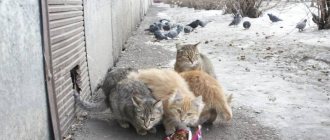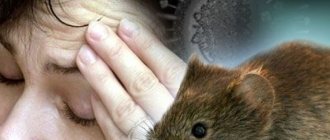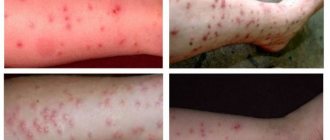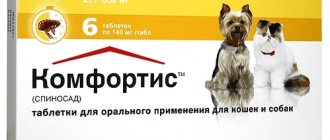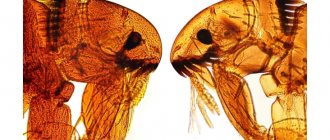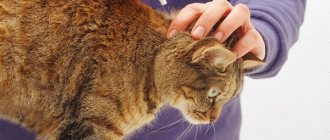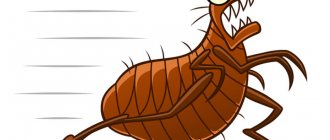Fleas are common parasites of warm-blooded animals and humans that live exclusively on blood. When choosing a host, fleas prefer animals, but they also attack people, of whom small children suffer the most. Knowing how to treat flea bites in children, parents will be ready to relieve symptoms in time and prevent complications. We will discuss how to treat flea bites on a child, what ointments to use against flea bites for children, as well as effective folk remedies.
What infections can fleas carry?
Parasites feed on the blood of healthy, sick and even dead people and animals. When a flea bites a person, the viruses enter the skin and are carried throughout the body through the blood.
The most dangerous diseases that bloodsucking animals can carry:
- anthrax;
- salmonellosis;
- encephalitis;
- typhus;
- tapeworms;
- fungal infections;
- listeriosis;
- tularemia;
- plague.
The greatest danger is posed by fleas that live on rats. These rodents feed on spoiled foods and dead animals and carry dangerous diseases.
If rats appear in the basement of the house, you need to destroy the rodents and carry out a complete treatment of the room. Companies specializing in disinsection and deratization can best cope with this task.
Signs of flea bites
Flea bites on a child's head
You can distinguish flea bites from damage caused by other insects by the following signs:
- Flea bites in children are located chaotically, 2–3 pieces each. Single bites practically never occur.
- There are no anesthetic components in flea saliva. At the moment of the bite, the child experiences pain comparable to discomfort from an injection.
The immune system develops up to 14–16 years of age, so even one flea bite can cause an allergic reaction (rash, itching, swelling). It is important to ensure that the child does not scratch the injury site, as this increases the risk of infection.
How to treat flea bites
Therapeutic measures should be aimed at relieving itching and restoring damaged areas of the skin. Learn more about treatment in this video:
Most often, when treating flea bites, doctors prescribe the following drugs:
Diphenhydramine. This is an ointment that eliminates allergies and itching, and also has an analgesic effect. The drug has two release options: Dermadrin (ointment) and Psilo-Balm (gel). The use of ointments will provide a cooling effect that can last up to 5 - 6 hours. To treat bites, apply the drug with light movements to the affected areas. Fenistil. Before applying the product to the bitten areas, you must treat them with an antiseptic.
Carefully apply a thin layer of ointment to the wounds, and then apply a bandage. Within a few minutes the drug will begin to act
Children under 1 year of age are not recommended to use the drug. Hydrocortisone. This is a universal ointment that immediately stops an allergic reaction after flea bites. Relieves itching and has an anti-inflammatory effect. The product is perfectly absorbed, and to achieve a positive treatment result, it is enough to use the ointment 2 - 3 times. Use is contraindicated for children under 2 years of age.
There are other, no less effective remedies for treating flea bites. Almost all of them are available without a prescription
It is important to remember that before treating a child with any drug, you need to consult a specialist to identify contraindications and reduce the risk of side effects.
Common sites of injury
Insects do not choose the human body as their permanent residence. Here the temperature for their existence is low. They are comfortable living in carpets, upholstered furniture, grass and soil. In these places they lay eggs and hatch larvae. They only bite people. If there is an animal nearby, the insects fix their gaze on it.
Fleas, if necessary, can live for about a year and a half without food. But under normal conditions they eat repeatedly and greedily, receiving nutrition from the human body. The process of blood absorption lasts from a minute to several hours. Not all the blood is digested; a large amount is released with feces, which further increases irritation of the child’s skin.
As a rule, bite marks are found on the legs, arms, face and stomach, that is, on uncovered areas of the body. Individuals do not penetrate clothing and do not bite through it. Fleas feel great in a child’s head, leaving bite marks and spots. This can lead to such serious diseases as hepatitis, brucellosis, and anthrax.
Not all insects are infected, but if they see a similar problem on the baby’s head, they get rid of it urgently.
First, make sure that there are fleas in the child’s hair. You need to be able to distinguish them from lice. These insects require different approaches to treatment, and blood-sucking parasites can be recognized by the following signs:
- Fleas on children's heads are in constant motion; they do not stay in the hair part, but jump from one place to another, while lice live and lay eggs in the hair.
- The first ones jump on the head, and the second ones crawl.
- They are saved from lice by using special hair products and combing out nits. You won’t be able to get rid of fleas on children’s heads this way. Complete disinfection of the home, clothes and shoes, and pets is necessary.
How to get rid of lice
If you find lice on a child, you must immediately begin exterminating them. Pediculosis is recognized as a disease and, like all ailments, requires treatment. However, society’s stereotypes are such that many are ashamed of their children’s lice and carry out therapy at home without disclosing the diagnosis.
Therapy for pediculosis in children
The fastest and most painless way to remove blood-sucking fauna is to cut the hair to zero. However, this method is acceptable for little kids or boys who want to add brutal and aggressive notes to their image. Most people, for aesthetic reasons, do not want to part with their hair, and children are no exception. Thanks to the huge arsenal of pediculicides, such a radical measure is not necessary.
To remove lice from children, folk remedies and pharmaceutical preparations are used. The pharmaceutical industry produces creams, ointments, shampoos, sprays, and concentrates, which allows the consumer to choose a convenient form of release. But no matter what tool you decide to use, the head processing algorithm remains virtually unchanged:
- The product is applied to damp or dry hair.
- The treated strands are covered with a plastic cap.
- The drug is kept in accordance with the time specified in the instructions.
- The product is washed off with water. In most cases, the hair is additionally rinsed with a vinegar solution or diluted juice with an acidic environment.
- The procedure ends with combing out dead insects and nits. To do this, use a lice comb with frequent steps. Often, a combing accessory is included with the pediculicidal product.
After 7-10 days, the procedure is repeated, since almost all products do not kill nits, and combing cannot give an absolute guarantee that not a single individual remains in the hair.
Traditional methods
Traditional methods of getting rid of lice
However, such substances can cause burns on the child’s delicate skin and damage the hair structure. More gentle means include vinegar, cranberry, pomegranate, which destroy the adhesive substance with which nits are fixed to the hair. Essential oils and herbal tinctures, tar soap are more famous for their repellent properties and are used as a preventative against lice.
Pharmacy products
Remedies for children against pediculosis
The pharmacy chain offers a wide selection of drugs. The most effective ones that can be used for children:
- Products for children from 6 months are represented by the only drug Nyx. Available in the form of a cream, the consistency of which is similar to shampoo. A bottle costing from 700 rubles is enough for 2 treatments of short hair.
- For children over one year of age, the Nit Free brand offers a large selection of products. Preparations based on natural ingredients and essential oils. Disadvantages: too oily structure, which makes the product difficult to wash off, and high price. Paranit Sensitive liquid is also produced for small babies. The peculiarity of the drug lies in its application. Moisten dry hair with the product until completely moisturized and leave for 6-8 hours.
- Preparations for treating the hair of children over 2 years old. Shampoos: Nok, Pedilin, Sumitrin. Sprays Lavinal, Para Plus (from 2.5 years).
- For three-year-old children, the choice is expanded with Paranit, which contains oils and no chemical components. Like all oily preparations, it is difficult to remove from hair. Nuda spray is also recommended for children of this age category. The advantage of the product is the ease of application to the hair.
- For children over 5 years of age, almost all pharmaceutical pediculicidal products become available. The range is expanding with the following drugs: Hygia, Veda, Pediculen Ultra, Full Marks, Nittifor, Medifox.
Causes and symptoms
First aid
Tavegil
If your child is bitten by fleas, wash the wound with cold water and antibacterial soap. If you are allergic to bites, you should use any antihistamine. Suitable for treating children:
- Diprazine.
- Fenistil.
- Diazolin.
- Suprastin.
- Tavegil.
Before giving medicine to a child, you need to read the instructions, which indicate at what age the drug can be taken.
Flea bites can be lubricated with the following products:
- ethyl alcohol or vodka;
- baking soda solution;
- Sulfuric ointment;
- calamine solution.
If a child scratches the skin, the wounds should be treated with brilliant green or iodine. If desired, you can use pharmaceutical ointments (Nezulin, Bepanten or Psilo-balm). To prevent further scratching, the treated areas are bandaged.
Treatment methods
Flea bites do not go away without leaving a trace. And it's not just pimples and scabies. Other symptoms may also occur, such as:
- temperature rise to 38°;
- intestinal disorder;
- lymphadenitis;
- nervousness;
- rarely anaphylactic shock;
- itching, pain;
- allergic reactions.
The appearance of allergies is a possible phenomenon. Fleas really like the delicate skin of babies, which lends itself well to the pressure of insects, and supplies them with a valuable product - their blood.
In addition, fleas bite a child, and thereby spray an enzyme into his body that interferes with blood clotting. And if there are a lot of fleas, then there will be an increased amount of enzyme, which will provoke the appearance of a life-threatening rash. In childhood, the immune system is not developed enough to withstand such a problem.
In 50% of cases, the rash can cause angioedema, which in some cases has unpredictable consequences. Facial swelling is directly related to swelling of the laryngeal mucosa and the membranes of the brain. The danger lies in squeezing the blood vessels, which can lead to asphyxia. The appearance of neurological disorders, including epilepsy and its accompanying manifestations, is possible.
If fleas have bitten a child, what to do in this case. After all, mothers constantly hear the baby crying, see his arms and legs covered with a rash. This deprives them of sleep and peace.
First aid steps for parents:
- calm down yourself and calm the baby;
- wash the puncture sites with a soap solution, preferably an antibacterial one;
- Treat the wounds with hydrogen peroxide and apply ice to relieve itching and pain. Instead of ice, a napkin moistened with cold water is suitable;
- lubricate problem areas with ointment that relieves itching or an alcohol solution;
- To prevent scratching, wounds can be bandaged.
A child is bitten by fleas at home, what to do after rescue measures. Bedding and clothing should be disinfected immediately.
If parents are used to using chemicals, but there are none in the house, they use folk remedies that are always at hand and work no worse than chemicals.
Folk remedies
When the actions of fleas do not cause complications, treatment consists of disinfecting the bite site, relieving swelling and itching.
How to treat flea bites in children at home:
- Potato. Make juice or grate the vegetable to obtain a paste. Apply the workpiece to the wound.
- Soda. Prepare a solution and use to relieve irritation and itching.
- Herbal infusions (decoctions). The best herbs to relieve irritation are plantain, chamomile, and calendula. Use as a compress.
- Aloe. Apply crushed sheet.
- Lemon plus honey. Mix a 2:1 tablespoon of freshly squeezed lemon juice with honey. Suitable for compresses.
- Apple cider vinegar. Prepare a solution to relieve itching.
Having chosen what to anoint your child’s flea bites with, perform the procedure repeatedly, then you will be able to relieve your baby from itching and pain in 3-4 days.
Pharmacy drugs
There are many medicinal herbs that help cope with the consequences of flea bites. A good effect can be expected from decoctions of Chamomile, Calendula, Plantain and other plants, the infusions of which can be purchased at the pharmacy.
In addition to herbal preparations, the pharmaceutical industry offers what to apply to flea bites on a child:
- medical alcohol;
- brilliant green or iodine;
- potassium permanganate solution.
The products are used to disinfect wounds and adjacent skin. Swelling can be removed with drugs such as Fenistil-gel, Boro Cream Plus, and Zvezdochka Balm.
- flucinar;
- Elidel;
- sulfuric ointment;
- ointments with retinol;
- ointments containing steroids;
- calamine lotion.
Each remedy has contraindications, so it is better not to take steps, but to take the advice of a doctor. If a child has fleas in his head, but the parents don’t know how to get rid of them, you need to try the methods described above. Otherwise, seek help from a clinic.
A doctor treats exacerbations after flea bites. Independent actions should not be taken to avoid further exacerbations. In such cases, the doctor prescribes antipyretics, sedatives and antihistamines. The dosage and method of administration depends on many reasons.
Flea bites in children are quite easy to recognize. While sucking blood, one individual makes several punctures in the skin. In addition, the location is also characteristic; usually these are the most tender areas of the legs, the top of the feet, and less often the arms and neck (if the child was bitten while sleeping). In addition, the bites of these parasites are quite painful and it is extremely difficult not to notice them.
So, what does a flea bite on a child look like? Depending on the body's reaction, this may be:
- Several small red spots, with subcutaneous microhemorrhages in the center.
- Red spots with slight swelling and thickening of the skin around.
- In addition to the bite marks, a rash resembling hives is present on the child’s body.
Photo of flea bites on the legs of an infant Photo of flea bites on the legs of a small child
After piercing the skin, the flea injects a special enzyme into the human blood that increases its outflow, which is often perceived by the human body as an allergen. In children, an allergic reaction occurs more often, for the reason that their immune system is not yet fully formed.
What does an allergy look like in a baby? The following symptoms are usually observed:
- body temperature 38-39°C;
- enlarged lymph nodes;
- rash or severe swelling of the skin;
- diarrhea;
- anxiety, irritability.
If you find one or more signs of an allergy to a flea bite, your child should be urgently shown to a specialist. This condition is dangerous for young children and can lead to anaphylactic shock.
If strange rashes are found on the child’s body, parents should find out whether there are fleas in the house. If you have pets, they must be carefully examined and, if necessary, treated. If there are no living creatures in the house, you should carry out one simple test. You need to spread white paper on the floor and observe its surface for 15 minutes. Jumping black dots will indicate that the child was bitten by this particular type of parasite.
How to treat flea bites in a child? A set of remedies for any insect bites should include antiseptics and antihistamines. They should be chosen based on the age and weight of the baby. In addition, it is important to avoid scratching the wound, which is sometimes very difficult to do. So, the procedure is as follows:
- Treat the wound with any antiseptic or soap.
- Give your child anti-allergy drops or tablets (antihistamines).
- Eliminate itching using ointments (Boro-plus, Calamine lotion, Psilo-balm, Rescuer, Fenistil-gel and others) or traditional medicine.
Folk remedies
A folk remedy for fleas for a child can be prepared from a regular set of kitchen products. Here are a few recipes to help relieve itching:
- Add one teaspoon each of baking soda and ammonia to a glass of warm boiled water. Stir thoroughly and treat the bite areas. You can do without alcohol.
- Grate one medium potato and onion (raw). Mix the resulting pulp and apply it as a compress.
- Add a tablespoon of honey to a glass of freshly squeezed lemon juice and then apply to the sore areas.
- Dilute a tablespoon of natural apple cider vinegar in a glass of boiled water. Treat affected parts of the body.
Zelenka and 2 ear sticks
How to treat a flea bite on a child if he scratched the wound? Spread it with brilliant green, and after the skin dries - with sulfur ointment.
With proper treatment, the swelling around the bite site disappears on day 2, and after 4 days the skin is completely restored. However, curing a child is not enough. To prevent the situation from happening again, you should get rid of fleas in your home once and for all. All animals must be treated, and wearing a special collar is recommended to prevent parasites. Things and furniture in the house (especially carpets, sofas, bed linen, blankets) need to be thoroughly cleaned using disinfectants.
If parasites are not found at home, you need to find out whether the child was bitten by fleas in kindergarten. This happens when sanitary standards are not followed. To begin with, you can have a conversation with the teacher, interview other parents. If your suspicions are confirmed, you should take action by contacting the SES (Sanitary and Epidemiological Station).
How to cure fleas in a child without medications? You can help after a bloodsucker bite using folk remedies that relieve itching and inflammation.
What can you apply against fleas on a child:
- Acid wipe. Dilute table/apple cider vinegar 2 times with boiled cool water. Wipe the affected areas and then leave as a compress for 10 minutes.
- Prepare a water mixture from baking soda. Apply the paste onto the bite until the moisture is completely absorbed. Remove dry residue with sterile material.
- Mix honey and lemon juice (proportion 1 to 2) and apply ointment against flea bites 4-5 times a day.
- Make a mixture of mashed potato mass and onions and apply as a compress 5/7 times a day for 3-6 minutes.
These remedies are used if there are no allergic manifestations after flea bites.
- A child’s skin is thinner and more vulnerable – so a flea bite is especially painful, it can be scratched and does not go away for a long time.
- Children are prone to allergies because... their immune system is weaker than that of an adult.
- The flea is a carrier of infections and eggs of most helminths (we talk in more detail about the danger of fleas to humans here).
Flea bites on a child's head
In adults, flea bites are less pronounced than in children. The child becomes restless and irritable, the affected area becomes very dense, and a blister with a red halo appears. Severe itching appears almost immediately. Insects easily bite through the delicate skin of children, so bite marks can be found on any part of the body, including on the scalp. The legs, arms and face are most often affected.
- Vinegar. Mix the apple product with water in equal proportions. Treat the bite areas with a ready-made product (for convenience, you can use a cotton swab). Vinegar will soothe irritated skin, relieve itching and redness.
- Aloe. Cut a plant leaf lengthwise and apply the inside to the affected areas of the body. Secure with adhesive tape or bandage.
- Decoction of medicinal herbs. Mix plantain, coltsfoot, calendula, chamomile and green tea in equal proportions. Place 2-3 tbsp in a saucepan. l. collection, pour boiling water over low heat. After 15 minutes, remove the pan from the stove and strain the liquid. Wipe the skin with the prepared decoction several times a day.
- Baking soda. Pour 1 tsp. baking soda with a glass of warm water, stir. Use the resulting solution to wipe the skin, lotions or compresses.
If there are a large number of bites, the skin should be treated with a solution of honey and lemon juice. To prepare the product you will need 1 spoon of beekeeping product and 2 glasses of freshly squeezed juice.
Folk remedies
The following remedies will relieve pain:
- Vinegar. Mix the apple product with water in equal proportions. Treat the bite areas with a ready-made product (for convenience, you can use a cotton swab). Vinegar will soothe irritated skin, relieve itching and redness.
- Aloe. Cut a plant leaf lengthwise and apply the inside to the affected areas of the body. Secure with adhesive tape or bandage.
- Decoction of medicinal herbs. Mix plantain, coltsfoot, calendula, chamomile and green tea in equal proportions. Place 2-3 tbsp in a saucepan. l. collection, pour boiling water over low heat. After 15 minutes, remove the pan from the stove and strain the liquid. Wipe the skin with the prepared decoction several times a day.
- Baking soda. Pour 1 tsp. baking soda with a glass of warm water, stir. Use the resulting solution to wipe the skin, lotions or compresses.
If there are a large number of bites, the skin should be treated with a solution of honey and lemon juice. To prepare the product you will need 1 spoon of beekeeping product and 2 glasses of freshly squeezed juice.
Where to begin?
- Do not panic! Wash the bite site with any available antiseptic : it can be hydrogen peroxide, chlorhexidine, or even just water and laundry soap.
- Take steps to relieve the itching . You can apply a cotton pad with soda solution or an ice cube wrapped in a clean cloth to the affected area. A good folk remedy is to wipe the wound with apple cider vinegar diluted in water.
- If a severe rash appears, give your child an antihistamine .
Important ! The water should be cold - hot and warm water only intensifies the itching.
Allergic and toxic reaction at the site of the bite
The flea introduces extremely unpleasant toxins into the skin, which can cause both an allergic and toxic reaction. An allergic reaction is accompanied by very severe itching at the site of the bite. The skin turns red, unpleasant bumpy rashes appear, which continue to itch very much. So much so that many people, even adults, tear their ankles to living flesh. Swelling forms at the site of the bite and around it, the diameter of which depends on the susceptibility. Usually it is 5-15 cm.
The duration of the allergic reaction depends on individual susceptibility. Symptoms usually last 3-5 days, gradually subsiding.
If the allergic reaction is stronger than described above, the swelling is severe, extends beyond the bite site, the lymph nodes are swollen, the temperature rises - immediately take antihistamines and consult a doctor. In some cases, the temperature rises to 40 degrees and must be brought down.
Not everyone experiences an allergic reaction, but it is quite common.
Possible complications
Inflammation of the lymph nodes in a child
Children's bodies are especially susceptible to flea bites, so the skin reaction can be unpredictable. The development of complications can be determined by the following symptoms:
- increase in body temperature to +37…+38 °C;
- inflammation of the lymph nodes;
- problems with stool (diarrhea);
- severe allergic reactions (up to anaphylactic shock).
The most common complication is an allergy to flea bites. It develops for the following reasons:
- During a bite, the insect injects an enzyme that prevents blood clotting. The enzyme contains proteins that cause the development of allergic reactions.
- The child’s immune system is in the formative stage and cannot withstand negative external factors.
- Delicate skin is especially sensitive to insect bites.
If a child scratches the bites, wounds appear in their place, through which microbes enter the body. Parasites carry plague, typhoid, hepatitis and other dangerous diseases. There are known cases of fleas infecting children with helminths.
A child who has been attacked by bloodsuckers must be closely monitored. Even a slight increase in body temperature may indicate the presence of an infectious process in the body, so if any unusual symptoms appear, you should contact your pediatrician. After a thorough examination, the patient will be prescribed adequate therapy.
Signs of the presence of lice in hair
Children and lice
The condition of lice in medical circles is called pediculosis. In the first days of infection, lice in children practically do not reveal their presence and detection of parasites is difficult. A few bites do not cause much discomfort. When the population increases, the following symptoms of lice in children appear:
- severe itching caused by the introduction of an enzyme with the saliva of the parasite that prevents blood clotting;
- fresh lice bites present as red blisters;
- bluish spots may appear, which is due to the characteristics of the child’s body and the manifestation of an allergic reaction to insect saliva;
- enlarged lymph nodes in the neck;
- the appearance of yellow crusts, purulent wounds, tangles in the hair - such signs are caused by a secondary infection when scratching bite sites;
- with prolonged infection, the hair emits an unpleasant odor;
- In children with weakened immune systems, body temperature may rise and a febrile state may occur.
A photo of head lice in children shows all the symptoms.
Pediculosis
The term “parasites” refers to a whole group of various parasitic microorganisms - lice, mites, protozoa, bacteria and other individuals.
They feed on soft tissues and useful substances, are capable of multiplying and intensively dividing in the human body, as a result of which a number of negative symptoms arise.
Lice are small insects that land on the scalp and can multiply in the hair. Most often, lice are found in children who go to kindergarten, school, or other public places with large crowds of people.
When the scalp becomes infected with such parasites, a parasitic disease called pediculosis develops. It is observed in patients until the person is completely free of lice.
Apart from humans, head lice are not able to parasitize other organisms. This feature is the high level of adaptability of lice to live and reproduce on the human scalp.
No one is immune from the appearance of lice; they can appear at lightning speed on a person’s scalp, so it is important to detect their presence in time in order to undergo appropriate treatment.
Appearance of lice
Parasites have a faded, whitish, and sometimes grayish color. They have three pairs of legs. They are easy to notice visually on the scalp, but lice are very agile and are able to quickly move from one place on the head to another.
Nits are the specific membranes in which lice eggs are located. They consist of a sticky substance, so they are quite difficult to separate from the hair. Any nit contains only one egg. As a rule, they are attached to individual hairs.
If a person has lice, the first thing you might notice is the nits. They are small oblong white balls that stand out especially against a dark background - dark hair.
When there are a huge number of lice on the hair, even after careful hygiene procedures, in particular, washing the scalp, it seems that small white grains have been scattered on the hair.
Features of the appearance of nits:
- The size of the nit is approximately one millimeter.
- Outwardly, it looks like a round and oblong ball.
- When examined under a microscope, you can notice the adhesive component in the shell.
Causes and symptoms
Since parasites appear in places with poor sanitary and hygienic conditions, the main reason for their appearance is failure to comply with basic hygiene rules. Lice can be transmitted through underwear or bedding, through hats and other personal items.
An interesting fact, but lice can exist freely in open bodies of water, and even in a swimming pool where sanitary and hygienic requirements are not met. Swimming in them can cause you to become infected with lice.
In a number of situations, parasites can “hide” in the folds of clothing, where they lay their eggs; it is almost impossible to detect them. However, they crawl onto human skin to feed; in this case, areas of the skin such as the armpits, groin area, and back are affected, that is, in those places where clothing fits most closely to the human body.
Lice can also appear under the following conditions:
- Long journeys, trips when it is not possible to fully comply with hygiene rules.
- Seasonal work with large crowds of people.
- In children's institutions where children closely communicate and make contact.
- In other places where there are large crowds of people (sanatorium, hospital).
It is in such places that you should follow all the rules of hygiene and do not forget about preventive measures, which will avoid infection, thereby eliminating subsequent treatment.
As practice shows, the appearance of lice is quite difficult to notice. In some cases, parasites can manifest themselves immediately after a couple of days from the moment of infection; in other situations, they can remain on a person’s head for a couple of weeks, and there will be no signs of their presence.
We suggest you read: Nematodes in humans, symptoms and treatment
If an allergy starts
Allergies occur in a child due to the following reasons:
- weak immunity;
- predisposition to allergies;
- infection through scratching the affected skin.
Attention! With severe burning and pain, a baby can often experience anaphylactic shock due to flea bites. An allergy resulting from insect bites is called pulicosis. The appearance of such a reaction signals to adults the need for medical attention.
Advice! At the first sign of an allergy, the child is given an anti-allergy tablet (Diazolin, Cetrin). It is necessary to wash the wound with soapy water and apply a special anti-inflammatory agent.
It is necessary to treat the skin with an antiseptic: brilliant green, iodine. This will protect the wound from suppuration and the spread of infection.
How to keep children safe?
Flea remedies
Preventive measures will help prevent flea bites in children. The main thing is disinfestation of residential premises. Before you start treating the apartment, you need to destroy parasites on pets. Shampoos, sprays, drops, collars and other means are suitable for this. You can find out which one is suitable for your particular pet from your veterinarian.
Fleas live not only on the body of the owner, but can also hide under baseboards, in carpets, floor crevices, upholstery and even in cribs. The treatment of the premises must be comprehensive. Anyone who is not confident in their own abilities should contact a specialized company. Exterminators use drugs that are poisonous to fleas, but safe for humans and pets. The result is the complete destruction of bloodsuckers and their larvae.
To avoid re-infection, you need to ensure that children and pets do not have contact with stray animals. Cats and dogs should walk in anti-flea collars impregnated with special compounds.
To protect your child from insect attacks outside the home, you can use special ointments or sprays. The content of the active component (DEET) in them should be no more than 5–10%. Children under 3 years of age are a contraindication to the use of repellents.
How does infection occur?
Ways of lice infection
Despite the fact that anyone can become infected with lice, regardless of age, social status and financial situation, children and adolescents are most often exposed to lice infestation. There are several ways where lice come from:
- Visiting preschool and school institutions. Children are constantly at close range and direct contact with hair occurs often: during games, sitting at the same desk. It only takes one infected person to appear in a group for an epidemic to begin.
- School locker rooms can also lead to lice infestations. If adults are wearing a headdress, it will not be difficult for them to crawl into the next hat.
- The possibility of “picking up” lice in crowded public transport is not excluded, where the parasite can literally migrate “over the heads”.
- Wearing contaminated hats, using other people's combs, hair clips.
- Visiting a hairdresser who is negligent in handling tools.
- Swimming in open waters or pools without a protective cap.
Lice do not appear after a child comes into contact with pets or stray animals. They belong to parasites of narrow specialization and each species of warm-blooded animals has its own variety of lice eaters. Also, lice do not live under the skin and are not a consequence of nervous shock or stress.
We suggest you read: Itchy head, what to do - methods of getting rid of torment

